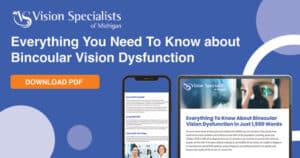
How BVD Symptoms Can Be Mistaken for Learning Disabilities
The symptoms of Binocular Vision Dysfunction are strikingly similar to those of certain learning disabilities. Due to the significant overlap between these two conditions, it can be very difficult to differentiate between them without the appropriate tests being performed. Many times when a child consistently struggles with reading and writing, has problems focusing in class or is easily frustrated, teachers recommend having them tested for learning disabilities or behavioral disabilities such as ADD and ADHD, but due to lack of awareness, do not refer them for a BVD evaluation.The Many Symptoms of Binocular Vision Dysfunction
BVD is a visual condition in which the eyes have trouble working together as a unit to aim both eyes at the image. One common form of BVD is Vertical Heterophoria (VH). VH occurs when there is a subtle vertical eye misalignment present. The eye muscles, which work to correct the misalignment, become fatigued and overworked due to the constant strain being put on them. This can result in a variety of symptoms, including:- Lightheadedness & dizziness
- Blurred vision
- Reading difficulties
- Vertigo
- Problems focusing
- Migraines & headaches
- Anxiety
- Irritability
- Double vision
Treatment With Aligning Lenses
Many people assume if BVD was present, it would be caught during a regular eye exam. The truth is, however, that most eye doctors don’t have the specialized equipment or training to detect the very slight misalignments of VH or the other binocular vision disorders. Vision Specialists of Michigan has all the latest technology necessary to perform the comprehensive examinations required for diagnosing BVD (known as the NeuroVisual evaluation). In addition, we employ an innovative treatment method using aligning micro-prism lenses, which has been shown to significantly reduce (and sometimes eliminate) the symptoms of BVD. To find out if your child’s learning disability or behavioral disability could be due to a binocular vision disorder, give us a call today at [company_phone].In recent years, parents and teachers alike have lamented the increasing number of children who have been diagnosed with learning disabilities and behavioral disabilities due to their inability to progress in school. Many of these children have difficulty concentrating, and struggle with reading and writing to such an extent that they become easily frustrated and irritated. If your child is experiencing problems such as these, the next step often involves testing for learning disabilities. However, there may be another common (yet not commonly thought of) condition at the root of your child’s challenges – a visual condition known as Binocular Vision Dysfunction (BVD).How BVD Symptoms Can Be Mistaken for Learning Disabilities
The symptoms of Binocular Vision Dysfunction are strikingly similar to those of certain learning disabilities. Due to the significant overlap between these two conditions, it can be very difficult to differentiate between them without the appropriate tests being performed. Many times when a child consistently struggles with reading and writing, has problems focusing in class or is easily frustrated, teachers recommend having them tested for learning disabilities or behavioral disabilities such as ADD and ADHD, but due to lack of awareness, do not refer them for a BVD evaluation.The Many Symptoms of Binocular Vision Dysfunction
BVD is a visual condition in which the eyes have trouble working together as a unit to aim both eyes at the image. One common form of BVD is Vertical Heterophoria (VH). VH occurs when there is a subtle vertical eye misalignment present. The eye muscles, which work to correct the misalignment, become fatigued and overworked due to the constant strain being put on them. This can result in a variety of symptoms, including:- Lightheadedness & dizziness
- Blurred vision
- Reading difficulties
- Vertigo
- Problems focusing
- Migraines & headaches
- Anxiety
- Irritability
- Double vision
Treatment With Aligning Lenses
Many people assume if BVD was present, it would be caught during a regular eye exam. The truth is, however, that most eye doctors don’t have the specialized equipment or training to detect the very slight misalignments of VH or the other binocular vision disorders. Vision Specialists of Michigan has all the latest technology necessary to perform the comprehensive examinations required for diagnosing BVD (known as the NeuroVisual evaluation). In addition, we employ an innovative treatment method using aligning micro-prism lenses, which has been shown to significantly reduce (and sometimes eliminate) the symptoms of BVD. To find out if your child’s learning disability or behavioral disability could be due to a binocular vision disorder, give us a call today at (248) 258-9000.Filed Under:
Tagged With: learning disability, Reading and Learning Challenges,








